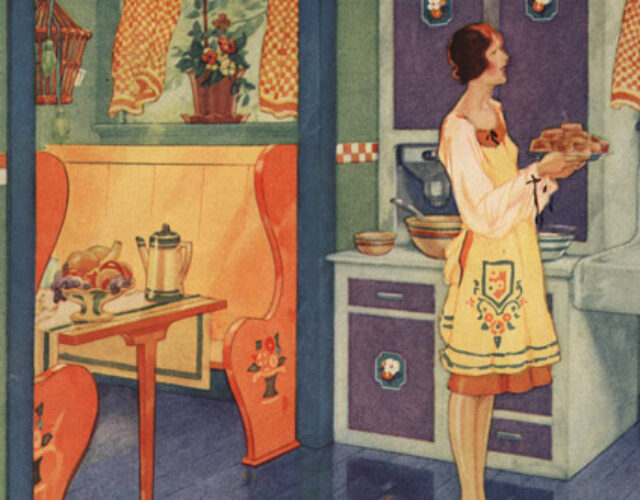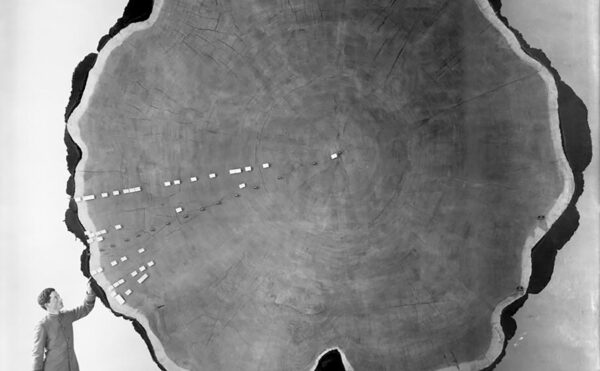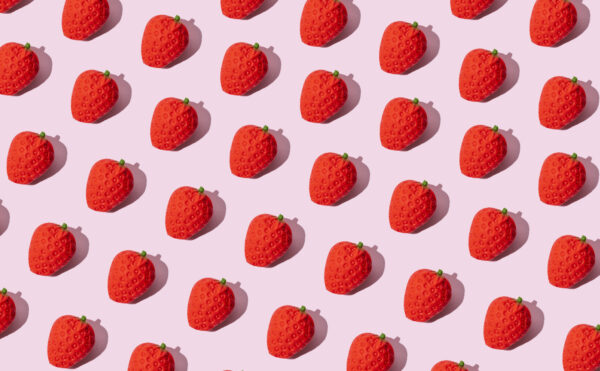In August 1926 Irénée du Pont, vice chairman at E. I. du Pont de Nemours and Company, wrote to Henry H. Bassett, general manager of the Buick division at General Motors Corporation (GM) with a proposition. During the early 1920s DuPont and GM, both under the leadership of Pierre S. du Pont, had developed Duco finish, a quick-drying, durable, inexpensive, and colorful automotive lacquer. More recently DuPont’s corporate colorists had created a distinctive palette for GM. Now the automotive giant, which used Duco finish on many of its cars, was trying to lure DuPont’s premier colorist, H. Ledyard Towle, to its Fisher Body division. Naturally, Irénée du Pont objected.
Towle ran DuPont’s Duco Color Advisory Service in New York, taking orders from automobile companies and advising them on style and color. The advisory service enhanced DuPont’s reputation as a trustworthy firm that responded to customers’ needs while safeguarding their aesthetic decisions. If Towle were to leave for GM, DuPont’s relationship with other automakers might be jeopardized. It was imperative that Towle—and Detroit’s trade secrets about color—remain at DuPont.
The DuPont-GM deliberations over Towle coincided with major shifts in corporate design practice during the 1920s. Companies making all types of products, from pots and pans to airplanes and automobiles, experimented with ways to increase sales. Efforts included mass advertising, installment selling, model changes— and color merchandising. Color’s popularity as a business tool led Fortune, the nation’s new corporate magazine, to publish a 1930 feature article “Color in Industry,” describing a “suddenly kaleidoscopic world,” in which color served as “a master salesman, a distributor extraordinary.” Fortune gave a catchy name to this monumental change: the color revolution.
In this context DuPont needed the expertise of colorists like Towle. Traditionally the fashion industry set the style trends in color, and others followed. Interpreting fashion colors for Detroit required special skills. Corporate colorists had to temper the sometimes outrageous hues generated by Parisian couturiers to suit Americans’ casual lifestyles and varied tastes. Another constraint came from manufacturers, who demanded cost-effectiveness. Automakers were caught between the efficiencies of black and an uncontrolled, expensive explosion of color. The rule of averages eventually dominated the great middlebrow market, the major audience for colorful cars. Middle Americans shared a desire for higher living standards, but they were divided by income, education, ethnicity, and social class. Commercial color became a tool for expressing this subtle tension; DuPont’s corporate colorists were the men who mediated the terrain.
Duco Innovation
Duco’s first colors originated from a DuPont–GM partnership that channeled managerial, engineering, and scientific talent between the two companies. By early 1922 the firms started to adapt Viscolac, a DuPont nitrocellulose lacquer used for painting pencils, into a new lacquer, Duco, suitable for automobile finishes. Until the early 1920s the only durable, inexpensive automotive finish was the famous high-temperature–baked black enamel that Henry Ford used on his Model T. Luxury cars, such as the Cadillac and Rolls Royce, came in a range of hand-painted colors, but even those varnishes faded, chipped, and scratched. Alfred P. Sloan, who had become GM president in May 1923, believed that consumers buying lower-priced cars would appreciate a range of color choices, particularly if the paints lasted. The automaker’s Oakland Motor Car Company decided to paint all seven of its 1924 touring cars with Duco; each got two shades of blue, with accent stripes of red or orange. This “True Blue” treatment made its debut on Oaklands at the New York Automobile Show in December 1923, dealers and consumers responded to the new aesthetic dimension and the promise of improved technical performance. By early 1924 orders poured into GM showrooms; “Duco has become so popular,” reported one executive, “that customers are now demanding it.” Recognizing that Duco was a sensation, Sloan recommended that GM apply it to all models. By mid-1925 GM’s divisions, from Chevrolet to Cadillac, were putting aside tried-and-true varnishes and enamels in favor of Duco.
Duco had several advantages over traditional coatings. Older varnishes were brushed on in more than a dozen steps and needed lengthy drying periods between coats. Quick-drying, spray-on Duco reduced the stages, drying time, labor costs, and storage space. Traditional varnishes chipped, cracked, crazed, and faded; Duco lacquer was almost invincible. It tolerated air, sun, rain, mud, dampness, heat, cold, salt water, bacteria, perspiration, dirt, soaps, and detergents. Most low-end finishes came in few colors, while Duco made available a rainbow of hues. Along with the annual model change and installment buying, the new finish added value to GM’s automotive line.
Even before True Blue’s debut, observers with their fingers on the pulse of the buyers’ market had been calling for colorful, mass-market cars that matched consumer tastes in fashion and interior design. The color revolution that swept across America in the 1920s built on transitions that had been under way for 75 years. During the gilded age English and German chemical companies introduced synthetic dyes that American mills used to make textiles in a variety of bright, permanent hues. Printers used chromolithography to generate colorful trade cards and posters for advertisers as well as decorative pictures for people’s homes. Even commercial streets touted new hues, as A&P supermarkets and Woolworth’s adopted bright red storefronts as part of chain-store branding. These novelties sharpened the eye and whetted the appetite for color.
True Blue’s success made the automotive and chemical industries take aesthetics seriously. Paint makers like the Egyptian Lacquer Manufacturing Company and Valentine and Company, determined not to be outdone by DuPont, introduced their own colorful paints, varnishes, and lacquers. In addition to automakers, local custom-shop painters adopted nitrocellulose finishes to refinish cars. Firms like Murphy Varnish and Ditzler Color developed chromatic aids to help custom painters understand the mysteries of color. Devices that simplified color selection democratized aesthetic decisions, which had long been the purview of artists and homemakers. These aids showed men, from top executives to shop mechanics, exactly what beauty could do for commerce and how its proper management could stimulate sales in the segmented automobile market.
The Duco Color Advisory Service
At first DuPont kept ahead by selling Duco to ever more car manufacturers and refinishing garages. By early 1925 its customers included five GM divisions and fourteen other automakers. That year DuPont sold more than one million gallons of Duco at five dollars each. Technically, Duco outstripped the competition, and the future looked bright. Yet DuPont managers who knew about color felt uneasy, knowing that the chemical company had to continually catch up with consumers’ growing sophistication.
In January 1925 two DuPont managers discussed the company’s need for practical advice on the psychology of colors as a means to anticipate major color fads. DuPont took a chromatic leap in October 1925 when it hired Towle and created the Duco Color Advisory Service to design the latest and most desirable color combinations for the auto industry. Born in Brooklyn, Towle had studied painting at the Pratt Institute and the Art Students League. During World War I he put his art training to good use as a member of the U.S. Army’s celebrated Camouflage Corps. Afterward he adapted to the burgeoning world of advertising, working sequentially as art director for three New York agencies: H. K. McCann, Frank Seaman, and Campbell-Ewald. At Seaman he also served as the executive in charge of the DuPont account and as copy executive for Cadillac, Oldsmobile, La Salle, and Pontiac—all GM divisions.
In the 1920s large New York ad agencies billed themselves as full-service companies prepared to help clients conceptualize campaigns, write copy, create artwork, design products, stimulate publicity, and conduct consumer research. Their art departments showed clients how to capitalize on color’s appeal in print advertisements and product designs. In this capacity, as Towle would later recall in an annual report, he “first worked on color with the automotive industry back in 1924,” when he was “the only color engineer calling on the automobile trade.” The painter-turned-artdirector seemed like a perfect fit with DuPont’s plans to rationalize the inchoate sphere of color
Duco Color Advisory Service advertisements in such trade journals as Autobody claimed that the service’s professionalism helped DuPont identify color combinations “known to please the average,” which Towle and his staff of color experts knew how to “choose with certainty.” This meant tying DuPont finishes to European fashion trends, keeping Duco abreast of changing tastes, and designing paint schemes that enhanced automotive shapes.
To advance the first mission, Towle sailed to Europe every fall, where he visited the British Motor Show at the Olympia in London and the Salon de l’Auto in Paris. There he studied the new cars and the smartly dressed people and cabled reports to the Duco Color Advisory Service, which repackaged them as press releases. Towle’s reports on color circulated in American popular culture as newspapers throughout the country published his lively, engaging descriptions. “All Paris is color mad!” Towle declared in the Providence Tribune in late 1926. The Grand Palais, which hosted the Salon, seemed aflame in warm maroons and burnt oranges. On snappy boulevards, autos of the “haute monde and the demi-monde” whirled by in “squadrons of satisfying color . . . like a flashing mountain torrent at the end of a rainbow.” Sometimes Towle shopped couture, taking notes at runway shows for trade articles on high-fashion fabrics. In the fall of 1926 he solicited automotive paint schemes from the major Paris couturiers. These style setters turned to glamorizing American cars: Lucien Lelong combined green and peach tones on a roadster, while Madeleine Vionnet’s flare for sports cars led her to decorate one in “tones of Dekkan Brown and London Smoke.” The list grew as Towle saw color nuance everywhere; he understood its place in the fashion system, and he sought to explain its significance.
Around the winter holidays Towle returned to New York for the National Automobile Show, where American car makers exhibited the latest engineering features, accessories, upholstery, and color schemes. Among the showstoppers at the January 1926 national show were 12 Lincolns decorated in spectacular hues adapted from the plumage of rare American and tropical birds: Ecuador’s green tanager, Haiti’s lizard-cuckoo, Venezuela’s yellow woodpecker, and more. One year later, colors at the show were even more stupendous. The “mass production man,” Towle reported in the Brooklyn Standard Union and the Pittsburgh Gazette-Times, had caught on to the fact that “the whole country is becoming more fond of the use of color.” Auto plants expertly wielded paintbrushes, showing cars with two-tone schemes in “warm, appealing beautiful harmonies.” They made fenders, window brackets, rear-tire covers, and upholstery to match the rest of the car. With satisfaction Towle described the 1927 National as “the high water mark in color harmony.”
This riot of color did lead to some design errors, and Towle was in his element with these problems. Some automakers went wild with the new nitrocellulose colors, ruining good models with injudicious paint jobs. Embracing a form-follows-function approach, Towle believed that a color scheme should bear some relationship to the car’s shape. The best paint jobs, Towle explained in a Brooklyn Standard Union article in 1927, accentuated the machine’s form and hid its figure flaws. “Long vigorous stripes along the lower band molding” made a model “look longer.” Why not, Towle posited, wrap the stripe around the car’s front? When people marveled at new, multicolored wheels at the 1927 National, Towle suggested they might like the polychrome effects that accentuated the car’s form. Towle was an aesthetic doctor with a stethoscope and a prescription pad. His patient was the visually naive auto industry; his medicine, judiciously applied color.
Towle Takes Charge of Color at GM
Between 1925 and 1928 Towle worked hard to put the Duco Color Advisory Service on a solid footing. He stuck with DuPont in 1926, despite GM’s overtures. In July 1928, however, he accepted the leading automaker’s offer and moved to Michigan. There he worked as GM’s first color engineer and most likely cofounded its Art and Colour Section with the flamboyant Hollywood custom builder Harley J. Earl.
As GM’s head colorist Towle issued a monthly forecast composed of a lively circular on general style trends and a statistical appendix listing car sales by color. Towle’s circulars went beyond a basic list of top-selling car colors; his detailed tabulations showed that consumer choices varied from region to region and from model to model. In a GM circular for June 1929, for example, he revealed that 87% of Pontiac buyers in the Pacific Northwest preferred shades of blue. In the Northeast only 17% of Buick buyers liked blue. The comparisons went on. Always a skeptic, Towle explained in the Society of Automotive Engineers’ trade journal that he checked dealers’ input against public taste as “revealed in the periodicals, in newspapers and over the radio as regards clothing, house furnishings and other articles.” His fashion antennae were always tuned to the consumer channel. Much about Towle’s method drew on hard facts, but much also depended on experience, intuition, and common sense.
Towle spent two years showing GM how to get a handle on the slippery matters of style, fashion, and taste. In 1930, however, he left GM to return to the Campbell-Ewald agency, this time to the Detroit office, where he specialized in outdoor advertising, including billboards and posters. He was happiest bridging color, design, and advertising. In 1934 he became founding director of the Division of Creative Design and Color at Pittsburgh Plate Glass, which created color schemes for appliances, layouts for showrooms and storefronts, new hues for paints and varnishes, and company advertising. He remained an important figure in the color revolution and extended its influence with his designs for industry, commerce, and architecture.
Duco Simplified with Munsell Colors
Towle’s successor at the Duco Color Advisory Service was another ad-man-turned-colorist, Howard Ketcham. A member of New York high society, Ketcham grew up in Manhattan and on Long Island and attended prestigious St. Paul’s School and Amherst College. From 1925 to 1927 he followed in Towle’s footsteps, working as art director for H. K. McCann while studying at the New York School of Design. In 1927 he joined the Duco office, where he worked until 1935. Then he established Howard Ketcham, Inc., a color consultancy in Rockefeller Center.
Ketcham inherited from Towle a color advisory service that stressed the market value of beauty as practiced in the industrial arts. Initially Ketcham continued these efforts through a joint project with Cheney Brothers, a silk mill that understood the fashion system. Cheney’s strategy pivoted on a three-tiered color portfolio: “novelties,” or new seasonal items, “second-season” lines, and “staples.” The high-fashion novelties, spun off the company’s color forecasts, yielded most of the profits. Over the years, Cheney’s sales director, Paul Thomas, had been very friendly to DuPont interests, supplying the firm with color forecasts for silk. Now he hoped that a tie-in with DuPont would clinch Cheney’s status as an industry leader. The Duco Color Advisory Service, in turn, expected to learn something about top-flight design and marketing.
In late 1928 DuPont announced a set of Duco car colors based on Cheney’s forecast for the following fall. It included Red Shadow Red, “a yellow red suitable for use with brown or beige, as a wire-wheel color or for striping,” and Sea Bubble, “a natural beige first developed by the silk industry which has received wide acceptance in the textile trade as well as in the automotive industry.” There were also Pewter Pot, Blu-Gray, Gray Gull, Bay Tree, Verdancia, Water Glo, and Lei Orange. The Cheney-DuPont palette continued Towle’s mission to augment DuPont’s cultural capital with high-class lines.
But although Ketcham recognized the importance of the industrial arts, this DuPont colorist also embraced the practices of the engineering profession (he was later called the father of color engineering). Alarmed at DuPont’s portfolio of 7,500 colors, Ketcham made simplification the raison d’être of the Duco Color Advisory Service. The trick lay in determining which colors resonated with the middle class, so as to both improve efficiency and increase sales. In his eight years as DuPont’s head colorist, Ketcham focused on rationalizing color forecasts and radically reducing the Duco palette.
Ketcham’s first step was to create the Automobile Color Index, a monthly quantitative analysis of Duco sales. This hybrid forecasting tool owed its analytical rigor to Towle and GM and its respect for fashion to Cheney. Emulating Cheney, Ketcham divided Duco colors into three groups: standard, style, and staple. Beginning in the summer of 1929 Ketcham tracked these three groups and measured the rise and fall of color families, such as reds, browns, and yellows. His research revealed how the Great Depression affected consumers’ buying habits. By 1933 black was back in business, a major challenger to blue. The Automobile Color Index summarized these trends in elaborate charts and graphs and showcased the statistical expertise of DuPont’s new chief colorist.
Next Ketcham unveiled DuPont’s full-fledged tribute to color engineering: Duco Calibrated Colors, a palette of 290 carefully selected hues. By 1932 American paint companies had 11,500 different automotive colors in their inventories. There was no logic behind this growth, which stemmed from a lack of planning. Many lacquer makers still offered colors that no one had ordered for several years. But the bigger problem lay in manufacturing practices. Some producers found it difficult to control chemical reactions in their factories, generating “as many as 80 variations of one original color.” Harried automakers exacerbated the problem when they accepted the off-color releases. Things also got worse when car companies switched paint suppliers, which unsuccessfully tried to match competitors’ colors. The end result was an increasing number of mismatches.
In creating Duco Calibrated Colors, Ketcham adopted the Munsell Color Company’s practical system of color measure to describe hue, value, and chroma. Whereas Towle subscribed to a psychology of color, Ketcham stressed hard facts. Writing for the refinishing trade, he described one two-toned harmony simply and directly: “Allover color a light maroon. The character of such a maroon can be improved through the use of light, bright blue green as a striping accent. Maroon is in reality a low value of red. Blue green is the complement of red. The use of a color with its complement tends to intensify both colors.” This language of efficiency had market value. Ketcham’s use of the Munsell system reflected Duco’s newfound awareness that color could be tamed, controlled, and packaged.
Ironically, Ketcham’s simplification plan sat squarely in industrial arts, where Albert H. Munsell did his pioneering research. During the 1920s the Munsell Research Laboratory and the Munsell Color Company pursued photometric research with the Bureau of Standards and publicized its system among schools and businesses. Between 1928 and 1930 Walter M. Scott, once the chief chemist for Cheney, worked as service director for the Munsell Color Company. Scott had used the Munsell system at the Cheney silk mill, which led to his enthusiastic promotion of it as an aesthetic tool for business. By the early 1930s Munsell’s practical method of color measurement was fast becoming the accepted standard in the industrial arts, and Ketcham proved wise to adopt it for DuPont.
In the 10 years between Towle’s arrival and Ketcham’s departure, DuPont experienced a remarkable transformation in color practice. Their temperaments and techniques differed, but both held common assumptions and recognized the fundamental responsibility of the colorist in the buyers’ market. “It is just as costly to be too far ahead of the color trend as it is unprofitable to lag behind it,” wrote Ketcham in the journal Industrial Finishing. “So, the manufacturer or dealer who wishes to meet markets when they arrive does well to determine in advance the public choice in colors.” Seasoned colorists thus learned to take their cues from the marketplace, whether watching ladies ogle Paris gowns or analyzing the sales of blue Buicks. They were, in short, “obliged to keep abreast of the consciousness of the color consumer.”
Why True Blue Mattered
The story of DuPont and the color revolution reveals much about the inner workings of the fashion system during the modern era. DuPont discovered there was nothing easy about the business of fashion. Men in the paint trade found it tough to pin down the feisty and fickle female consumer. In the end DuPont followed the textile trade, which, like other batch-production industries, had perfected a system of consumer mediation. The growing chemical behemoth even adopted the Munsell color system most favored in the industrial arts.
As DuPont standardized the Duco palette, the company helped to establish new ground rules for design innovation in consumer durables. By the mid-1930s Duco color choices embodied tastes in the great imagined middle ground—the mass market—while allowing for deviation. Blue appealed to conservatives, but the nation’s George Babbitts came in many different stripes. Besides True Blue there were hundreds of other blues, all geared toward the range of middlebrow tastes. This selection allowed middle-class consumers to signal differences among themselves.
The proliferation of forecasting systems gets to the crux of the matter. There was no one best way to predict color appeal precisely, because there was no single taste or single category of products. Yet whether in textiles or automobiles, palettes as a whole had mass appeal, and individual colors had a tad of distinctiveness. Each was designed to work with a specific line of products. A woman might wear a suit in Elsa Schiaparelli’s Shocking Pink for decades, but a Fire Red car got tiresome pretty soon. Exact copies of couture colors looked strange on fenders, doors, and upholstery. Men like Towle and Ketcham explained why. When industrial colorists spoke, corporations listened, and by the mid-1930s color experts had a toehold in American business culture.
This article draws on research for a new book, The Color Revolution, funded by CHF’s Edelstein Fellowship and a National Endowment for the Humanities Fellowship for 2007–2008.




